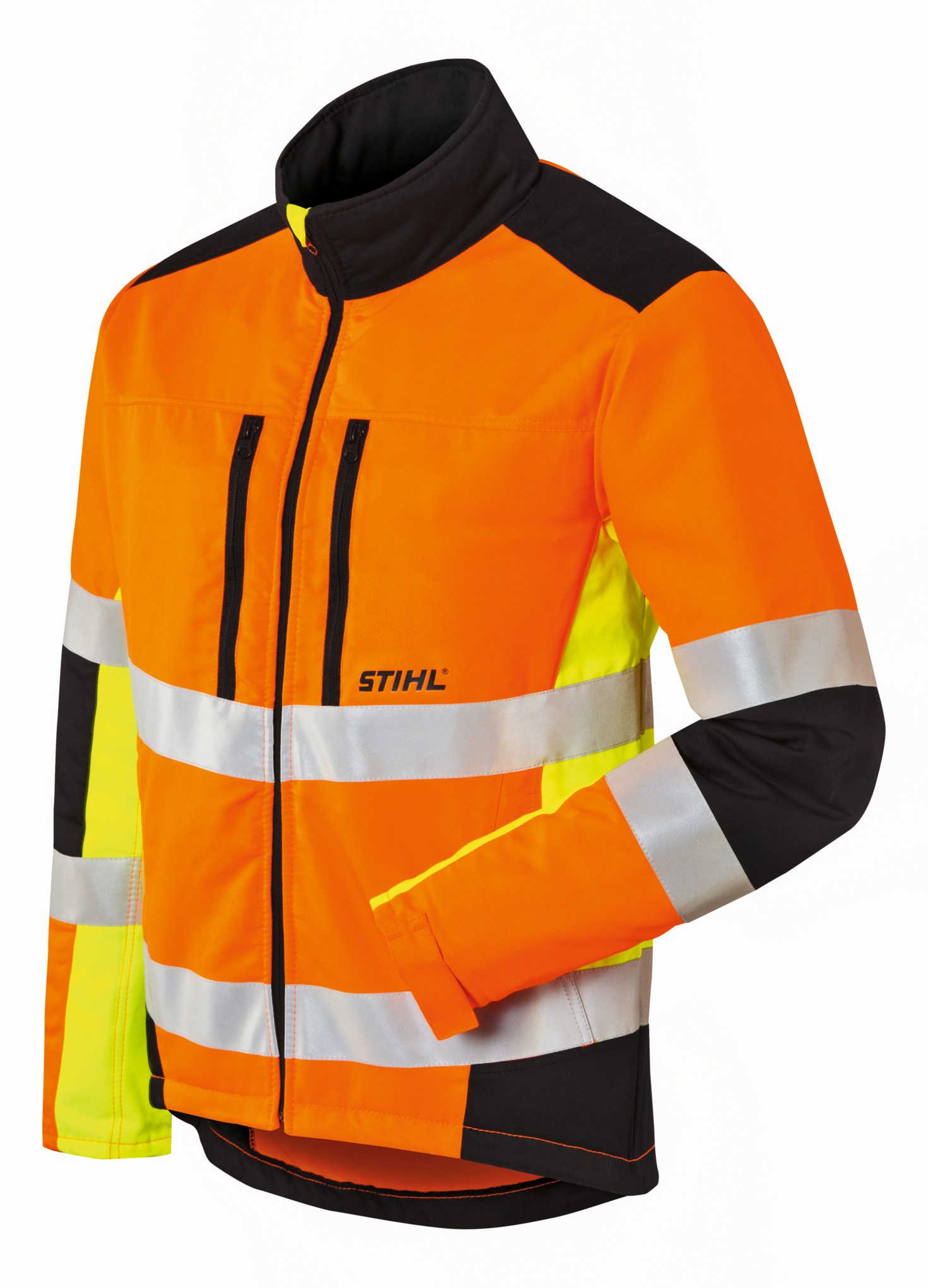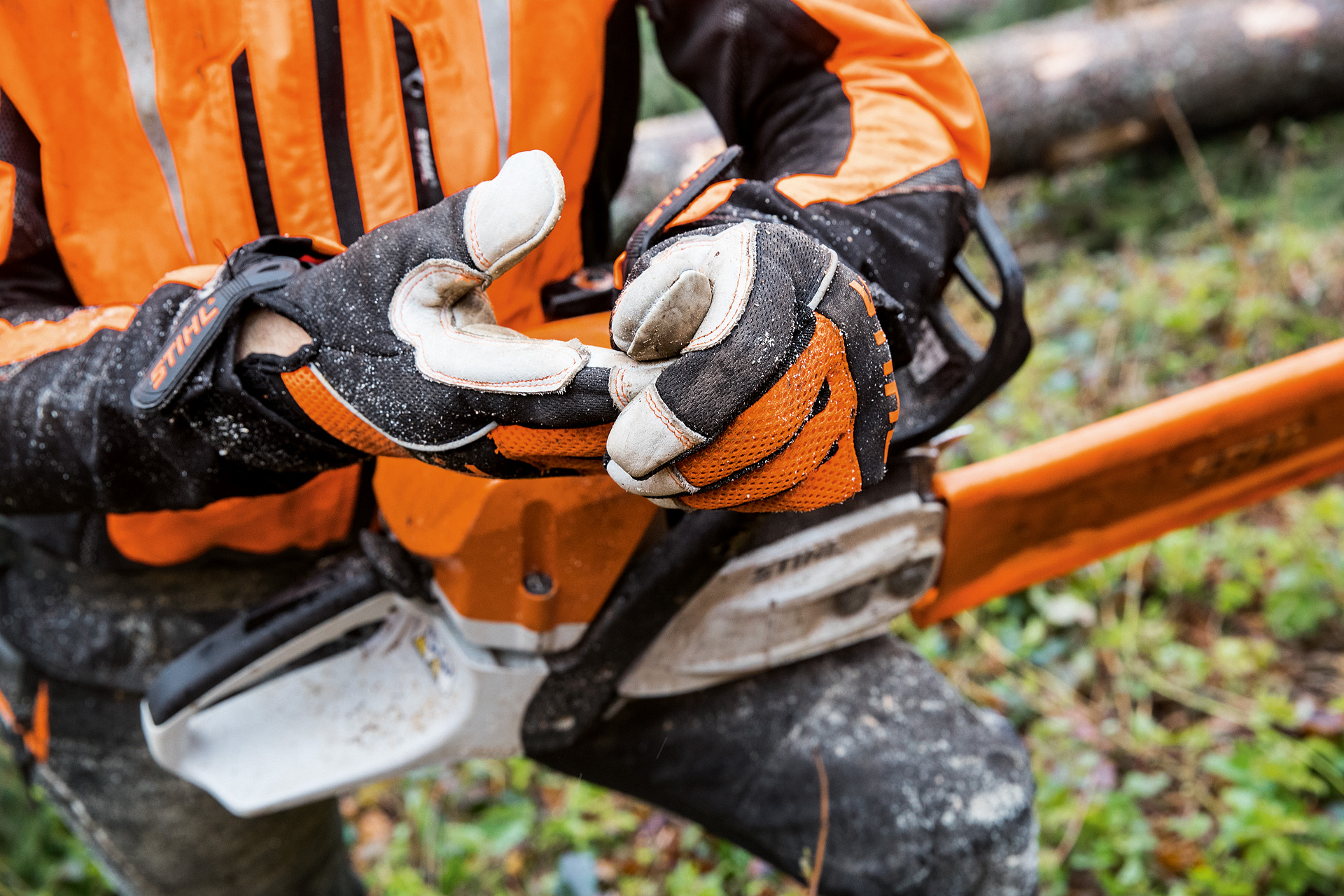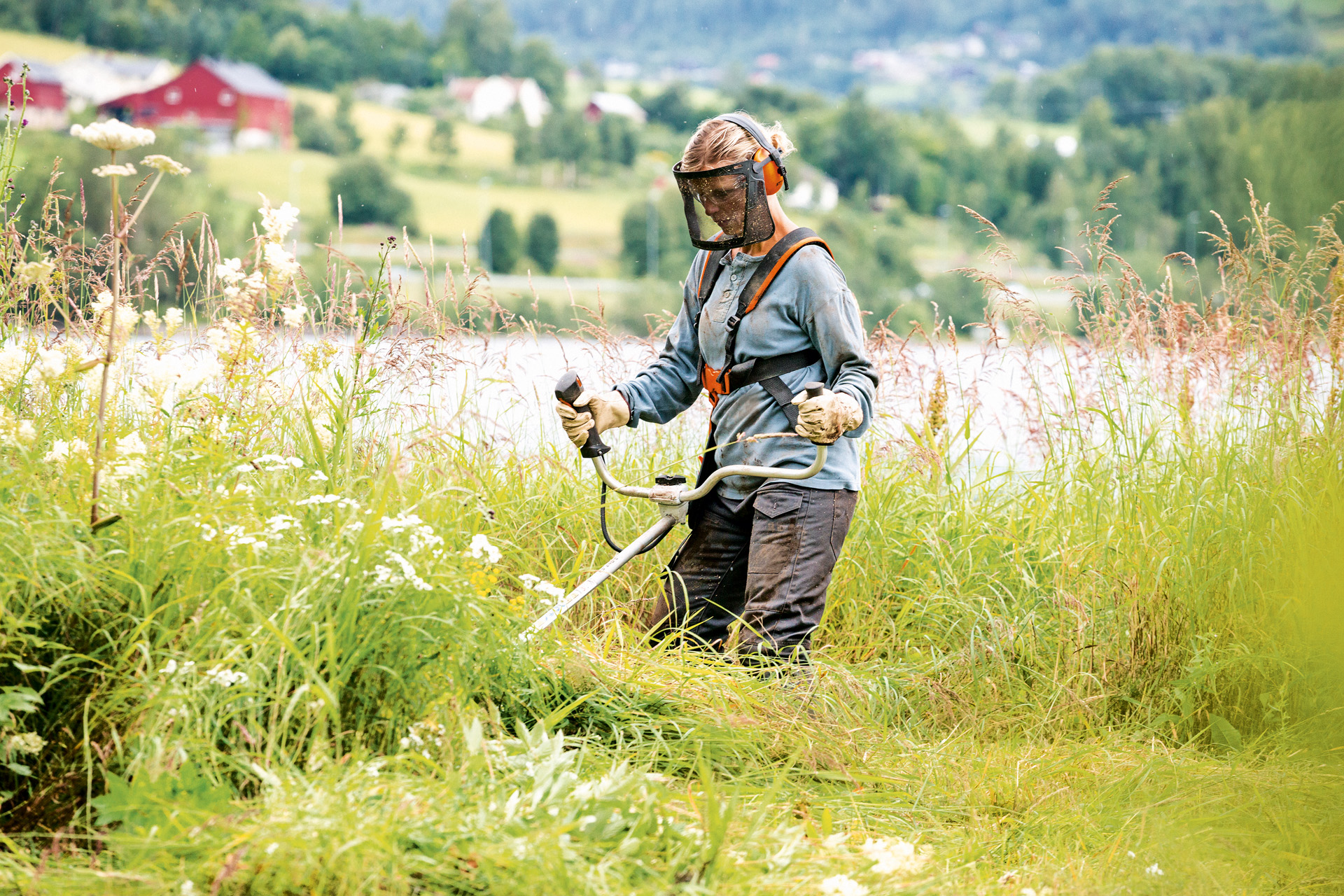Cut protection classes: PPE for increased safety
Appropriate protective clothing is essential when using a chainsaw to reduce the risk of injury.
09.10.2024

How chainsaw protective clothing works
All work clothing with cut protection generally follows the same principle, based on a need to impede the moving chain of the chainsaw in the event of accidental contact with the user’s body. STIHL chainsaw protective trousers, jackets and shoes do this using special, high-tech fibres; these fibres are arranged in multiple smooth layers and covered by the outer surface of the clothing. If a saw chain comes into contact with the clothing, it catches and pulls out the fibres in an instant, then the long threads wrap around the drive sprocket and quickly stop the chainsaw.
Chainsaw protection classes explained
Each type of protection equipment is not equally suitable for every type of user. Chainsaw protection classes are a way of designating clothing according to the maximum chainsaw speed it can effectively protect against. The four protection classes go from 0 to 3, and the individual designations are further explained below.
The lowest protection class offers sufficient protection at a chainsaw speed of up to 16 metres per second.
Chainsaw protection class 1 protects the wearer from chainsaw speeds of up to 20 metres per second. Of all the protection levels, class 1 offers the best compromise between protection and freedom of movement. This is the class generally used in forestry work and it is also recommended for home use.
Chainsaw protection classes 2 and 3 offer protection at chainsaw speeds of up to 24 and 28 metres per second respectively. Trousers and jackets start to be a little less flexible to wear from chainsaw protection class 2, as the higher level of protection affects the ergonomics of the clothing. As such, the higher classes are more practical for trained users in the professional sector.
Be aware that, because accidents usually happen when a chainsaw is stopping – so at relatively low speeds – chainsaw protection classes can only function as a guide. Factors such as the sharpness of the individual saw chain, its tensioning and the angle of impact cannot be taken into account in the standardised tests used to determine protection classes. Personal protective equipment cannot provide absolute protection from injury, nor is it a substitute for safe working practices. It is therefore essential to follow the instructions in the user manuals for both personal protective equipment and the relevant power tool, as well as any valid national accident prevention regulations.
Chainsaw protection classes: choosing the right level
Each protection class is intended for a specific scenario. Chainsaw protection class 1 is usually suitable for working in the forest or at home, while the higher protection classes are intended mainly for use by trained professionals such as the emergency services.
Chainsaw protection classes: STIHL protective clothing
STIHL offers cut protection clothing across the various classes, so you can be assured of effective protection while working with a chainsaw.
Protective trousers are the most important element of any chainsaw protection equipment, because it is the legs which are most at risk when working with a chainsaw. STIHL chainsaw cut protection trousers are available in the various protection classes and in two different variants: Design A and Design C, with the different options referring to which areas of the garment include resistant material. Design A trousers offer cut protection at the front of the leg, while Design C trousers offer protection all around the leg.
A chainsaw jacket is available in protection class 1, with cut protection on the shoulders, chest, stomach and arms. It also feature large areas of high-visibility colours, as this is another component of safety when working: wearing clothing which is at least 30% high-visibility orange in colour ensures you can be seen more easily in poor visibility and helps prevent accidents.

All our chainsaw boots include steel toe caps as well as a cut-resistant inlay. STIHL offers chainsaw boots in leather and rubber, and it all undergoes professional durability testing in our test laboratory.
- Cut protection testing in accordance with the standards for forestry boots
- Steel toe cap test: the toe cap must be able to withstand a 20-kilogram weight falling on it from a height of one metre.
- Flexural strength: in our test laboratory the soles are bent in a standardised groove 30,000 times, and they must not crack more than 4 mm.

When working with a chainsaw you must also wear suitable resistant gear on your hands. You should always wear sturdy gloves for chainsaw work, and gloves with a cut-resistant inlay offer additional protection. Our gloves are available in protection classes 0 and 1, and they are the perfect finishing touch to your complete safety package.

STIHL chainsaw protective clothing is tested by the very prestigious European SMP or KWF testing institutes. That is why you can be confident that any STIHL cut protective clothing will offer reliable, rigorously tested protection. This icon is used to identify cut protection clothing and shows they have passed safety testing in accordance with EN 381 or EN ISO 11393. In these standardised tests, the saw chain meets the protective inlay at a specified chain speed and must only cut through the inlay; the inner lining of the cut protection trousers must be completely undamaged.

Taking care of chainsaw protective clothing
Even if it's is not directly taking any impact, chainsaw protection clothing is constantly exposed to dirt. The best way to care for your chainsaw clothing is as follows:
- Machine wash at no more than 60 degrees Celsius and spin at 400 rotations per minute or less.
- Do not bleach, do not use chemical cleaners.
- Do not wash chainsaw protection products inside out.
- Close Velcro and zip closures before washing.
- Use mild detergent, but do not use fabric softener.
- Air dry after washing on a flat surface - do not hang from a line.
- Iron at a low temperature to reactivate the dirt- and water-resistance in the outer layer.
- Store clothing in a dry, dark place, ensuring it is thoroughly clean.
Protective boots also require special care to stay in good condition for a long time:
- Clean boots every time they are visibly dirty.
- Use water or a mild soap solution to remove stubborn dirt.
- Do not dry directly beside a source of heat.
- Do not dry in the sun.
- Store in a dry place.
For leather protective boots, you should additionally bear the following in mind:
- Treat with a shoe protection product or leather grease before first use.
- Wear in dry weather the first time – dust seals pores and seams.
- Use care products regularly but not excessively.
Summary: chainsaw protection classes
- There are 4 chainsaw protection classes, numbered from 0 to 3.
- The protection classes represent levels of resistance against different chainsaw speeds.
- Protection class 1 is the standard protection class.
- STIHL offers a range of chainsaw protective clothing.
- Always wear personal protective equipment when working with tools, as directed in your operating instructions, and be sure to check the sizing guide.



